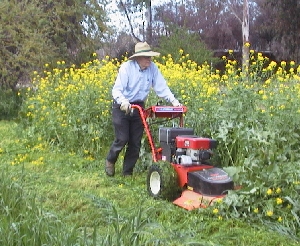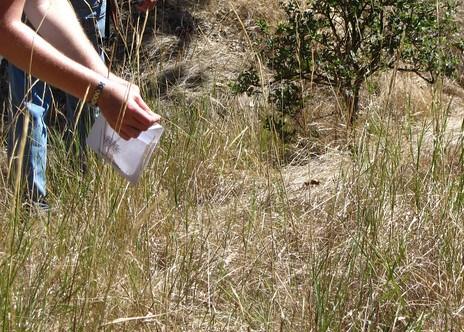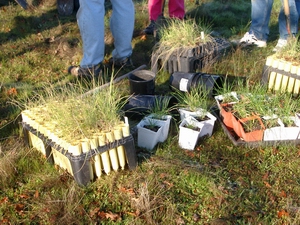Heather Farm Nature Area Restoration - 2002 to 2004
History
In spring of 2002 the Walnut Creek Park, Recreation and Open Space (PROS) Commission authorized creation of a task force to identify requirements for restoring the natural lake and 3 nearby areas in the Park. The task force initially included 3 members of the PROS Commission, 3 members representing the Mount Diablo Audubon Society chapter, 2 members representing the Walnut Creek Open Space Foundation, 2 members from the Gardens at Heather Farm (an organization that teaches classes and maintains extensive gardens in the park), 2 members from the Lindsay Museum and 2 members from the City of Walnut Creek staff. Task force members have been active in defining the restoration project and are a nucleus for implementing the restoration. Several individuals have also joined the task force.The project has been formally adopted as a Foundation project. Foundation members have been active in all task force activities. In 2003, the Foundation received a financial grant from the Contra Costa Fish and Wildlife Committee and a Civic Pride Grant from the City of Walnut Creek.
Defining the Project
We first discussed the goals for the restoration and produced a report for the City of Walnut Creek. This report described the state of the nature areas, how they should be improved and provided a roadmap for implementing the plans using community volunteersHeather Farm Habitat Report 2003[PDF]
The report described improvements that would make the nature areas better habitat for plants and animals and a more interesting place for park visitors. We have focused on restoring native plants to the nature areas as described in the report.

Mowing down the weeds in Heather Farm
Site Preparation and Inventory
We surveyed the nature areas to determine what trees, shrubs and small plants were already present. Audubon chapter members produced a list of birds seen in the park.Since there were indications that high levels of boron or other minerals might be present in the park, we took 20 soil samples and had them analyzed. We will be consulting Bethallyn Rogers, Urban Horticulturalist with the U.C. Continuing Education program, to interpret those results in January 2004.
Since May 2002, we have been suppressing the spread of weeds such as mustard and several thistle species by mowing and hand pulling. We hope to reduce the level of weed infestation in areas where it is a significant problem (about 1/3 of the total nature area).
Bob Wisecarver identified the need for more perching places in the lake and developed a method to anchor log segments in the water. These new perches were installed last summer and have proved popular with birds and turtles.
Seed Collection

Collecting native grasses in Shell Ridge
We located stands of native grasses (purple needlegrass nasella pulchra and foothill needlegrass nasella lepida) and several species of wildflowers and shrubs in the Walnut Creek open space in the spring and monitored the development of seed in those stands. As seed matured, volunteers harvested the seed and cuttings. Each stand matures at a different time, so small groups of 2 to 6 volunteers collected seed in a number of sessions over several months.

Grass ready for planting!
Propagating Plants
Starting at the beginning of August 2003, volunteers propagated seed and cuttings at the lath house at Heather Farm Park operated by the Gardens at Heather Farm organization. This activity continued until the end of October with regular weekly sessions. The Garden's staff provided effective training for project volunteers and we were able to use their greenhouse facilities to get our plants off to a good start.As plants grew, we moved them to larger containers. This was a more time-consuming effort but we were able to accomplish it with weekly sessions using small groups of volunteers in October. We produced over 1100 native grass plants ready to be planted in the park's nature areas in January. We also raised about 300 wildflowers to be planted in 2004.
Our germination rate for grass and flower seed was quite high. Most propagation sessions resulted in one or more seedlings in over 95% of cells planted. The purple needle grass plants (nasella pulchra) thrived as did Clarkia and red bugler penstemon. Some predation by unknown animals occurred especially on foothill penstemon in the greenhouse. Some plants were left in the very moist greenhouse environment for too long. We learned lessons for next year's effort. Overall, the process went smoothly with a higher level of success than anticipated.
Planting in 2003

Drilling holes to plant the grass plugs in.
Groups of students from Seven Hills School planting seedlings with us on Friday 1/16.
Our productivity of 40 to 50 plants per person was much higher than the 10 to 20 plants we had expected. We will have no trouble getting our remaining stock of about 600 grass plants in the ground in January.
From late spring through mid-summer of 2004, we watered seedlings in the park to get them a better survival rate in their first year.
Construction
We worked with the Rotary Club of Walnut Creek to identify projects they might do in the park. The Rotary Club has adopted construction of facilities in the park as their centennial year project. This year, they constructed a kiosk that we and the City Staff will use to educate the public about the nature areas in the park. Our project paid for the kiosk materials. In 2004 they are planning to install a pedestrian bridge that will provide public access to one of the nature areas. They will also be working on observation platforms at the edge of the lake.All our work in Heather Farm Park has been coordinated with the City of Walnut Creek's park maintenance staff and all plans are approved by the City staff.
Volunteers from 2004 Week of Caring helping to propogate plants for Heather Farm
Planting in 2004
In summer of 2004, the City of Walnut Creek funded projects to support our restoration work. Sycamore Associates produced recommendations for the project including plant lists for grassland, woodland, riparian and chaparral habitat areas. Consultant Karen McCardle produced a map showing trails and habitat areas.We again collected seed from the Walnut Creek Open Space in spring and summer of 2004. Volunteers from Chevron and Wells Fargo helped us propagate seedlings during the Week of Caring (September 13-18) organized by the Volunteer Center of Contra Costa. Students from several local schools have also participated in planting bunchgrass seed.
We expect to plant these bunchgrass seedlings in December 2004 and January 2005 with help from volunteers.
In fall of 2004 we are producing a detailed layout showing the placement of trees, shrubs, and smaller plants. We are also planning for implementation of our plan. We will be purchasing some plants in addition to those we grow as part of the project.
The Natural Lake
Towing a newly-planted floating island to its anchor point in the lake
We have done several things to enhance the lake's habitat values. Early in the project, Bob Wisecarver installed a turtle basking log in the middle of the lake. It has been well used. In 2012, volunteers put up wood duck boxes to encourage this shy but very attractive, cavity-nesting species to colonize the park.
There has been a long-standing problem with algae blooms in both the natural lake and the cement-lined pond, made worse over the years by our increasing population of Canada geese. Staff installed two floating islands in the cement pond this summer to process the nitrates. Water quality will be tested quarterly so we'll have data. We are all hoping this will solve the algae problem and improve habitat for the fish. If it works, we will raise money to install islands in the natural lake.




 Join
Join Donate
Donate Volunteer
Volunteer Maps
Maps Newsletter
Newsletter Facebook
Facebook

